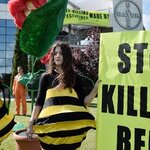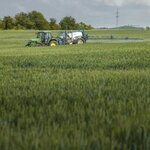Environment

China's richest provinces are having a huge environmental impact on the country's water-scarce regions, according to a new estimate by the International Institute for Applied Systems Analysis (IIASA) and the University of Maryland.
The new paper used the controversial concept of "virtual water," an economic idea used to estimate water flows through trade and track how water is traded through agricultural products and other goods that require water to produce. But while previous claims of water flows had treated all water equally, the new study factors in water scarcity for regions. …

Fish is good for you and has been growing in popularity.
Atlantic Bluefin Tuna is a much sought after delicacy, though the International Union for Conservation of Nature (IUCN) lists it as endangered. So far, farming of this species in the Mediterranean area involves capturing medium-sized specimens and fattening these in farms, which still depletes the wild stocks - but a sustainable solution may be available.
The EU-funded project TRANSDOTT wants to establish a sustainable and commercially viable aquaculture for Atlantic Bluefin Tuna by September of this year. “This is the only way to…

The reduction of soil carbon stock caused by the conversion of pasture areas into sugarcane plantations is very common change in Brazil in recent years but those worried about the impact on CO2 can rest easy. It can be offset within two or three years of cultivation.
The calculation by researchers at the Center for Nuclear Energy in Agriculture (CENA) of the University of São Paulo (USP) in collaboration with colleagues from the Luiz de Queiroz College of Agriculture (Esalq), also at USP, concluded, "Soil carbon stocks on land-use change process to sugarcane production in South-Central…

Though the central coast of California is some of the best farmland in the world, organic farmers who don't want to use modern science have a difficult time producing crops for their $35 billion and growing in corporate customers.
Yet science can help there also. Cover crops can provide weed and erosion control so scientifically determining the best method for establishing a uniform and dense cover crop stand as soon as possible after planting is a critical first step.
The authors of a new paper say that determining optimal planting strategies that accelerate cover crop emergence and…

It's not a bad idea to think about water. Though Earth is literally overrun with water only 2% is usable and current energy and technology limitations make it impractical to bring it to the areas that need it most, so management is important.
Water is the limiting factor for many plants and trees and climate models project hotter and drier summers for much of the globe. An international research team is studying which factors govern the resistance of tropical trees to periods of drought and fins that stored carbohydrates play a key role in the resilience of the individual plant.
While…

Organic farming boosts biodiversity - at least that is the claim of organic farmers. But it depends. It's a $35 billion business and there are plenty of gigantic organic mega-farms that aren't diverse at all.
In practice, the number of habitats on the land plays an important role alongside the type and intensity of farming practices, according to a study of 10 regions in Europe and two in Africa published in Nature Communications. Organic farms still use plenty of toxic pesticides and more chemical fertilizer than conventional farms but they can support biodiversity when they consciously…

Want to scare people about a pesticide? Compare it to DDT. 40+ years after it was banned in a bit of scientization of politics, people have still heard of it. DDT may be the only pesticide many people have ever heard of. Environmental groups love to invoke it for that reason.
But if you are a fan of science, when you see a DDT comparison, you know evidence has left the building. DDT, when misapplied, was bad, just like every other compound, including water, can be bad. There was nothing exceptional about it other than the fact that it could have saved millions of kids from malaria if…
Bill Hewlett famously said, "You cannot manage what you cannot measure." In our efforts to understand and manage our environment, one thing we lack are "baseline stations" -- places where the environment is essentially unmodified.
Here in Dallas, I'm fortunate to have access to the Trinity River Audubon Center; a brownfield remediation site where the Texas Honeybee Guild keeps a set of five beehives. With their kind permission, I am beginning a project to monitor them and their health and the health of their environment.

Senator Carl Levin (D-MI) announced at the National Marine Sanctuary Foundation's (NMSF) 12th annual Ocean Awards Gala last week that he is introducing the Great Lakes Cultural Heritage Assessment Act next month.
Levin's proposed bill would direct the National Oceanic and Atmospheric Administration to identify underwater areas in the Great Lakes that possess significant historical and archaeological resources and consider recommendation for designation as national marine sanctuaries.
The National Oceanic and Atmospheric Administration (NOAA) is releasing the final rule reopening…

In Europe, the presence of toxic chemicals has been considered a localized problem affecting only a few bodies of water but a new paper says there are large scale ecological risks for several thousands of European aquatic systems. The culprit: toxic chemicals.
They say that chemical toxicity represents an ecological threat to almost half of all European bodies of water, and in approximately 15% of cases, the biota in freshwater systems may even be subject to acute mortality.
The Water Framework Directive (WFD) by the EU is unlikely to be met due to the high levels of…